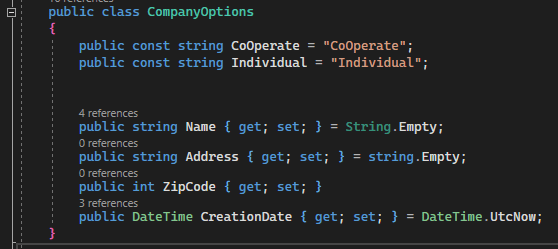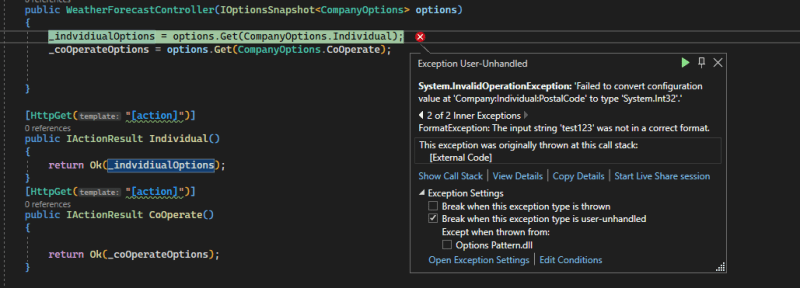A Guide to Validations in the IOptions Pattern for .NET Developers

Ahmed Shah
Posted on June 10, 2023
In the previous post I have talked about using named and typed IOptions pattern in .NET. link.
Let's see our C# class and appsettings file the we have created in previous article.
Considering the complexities that can arise within large projects relying on multiple configurations, it's not uncommon for developers to overlook updating appsettings files, encountering null parameters, incorrect data types, or typographical errors in names. It happens, but it can lead to issues.
Now, imagine your pull request merged and the project cloned by another developer or deployed to production. Runtime surprises and missing settings become evident, sometimes without any exceptions.
To address this, we can employ validation techniques both at compile time and runtime within the IOptions pattern. Let's introduce data annotations into our C# class.
Let change our Postal Code in Individual Company to string.
Notice I have individual Postal Code with a string value
now change the Company Settings in Startup to validate the data annotations.
first we will use compile time validations using .ValidateOnStart(); method on our Company settings like this in our program.cs file.
Let Run our project and see what happens.

As you see it throws exception for Company:Individual:PostalCode format exception which binds to string value instead of integer.
Now lets validate our appsettings during runtime and remove .ValidateOnStart().
I have just modified controller for both Individual and Cooperate Settings response se we can test both individually.
Note we have correct data in Cooperate and wrong data in individual settings.
Let run the project and see.
on executing any method the Company Options break because its being initialized in constructor of our controller. right now we are validating our Company Options at runtime.
Key Takeaways:
Utilize ".ValidateOnStart()" for compile time(when application starts) validation, especially on IOptions.
Utilize ".ValidateDataAnnotations()" for runtime validation, especially with IOptionsSnapshot and IOptionsMonitor.
By leveraging these validation techniques within the IOptions pattern, we can ensure robust configuration and mitigate errors that may arise during development and deployment.
Feel free to reach out for any inquiries or further discussions. Github Code Link link.

Posted on June 10, 2023
Join Our Newsletter. No Spam, Only the good stuff.
Sign up to receive the latest update from our blog.
Related

June 14, 2023







